|
|
| Legal
Chinese Currency April 2010 |
|
|
New for January 2014:
1, 000 RMB banknote issued!
China currently issues two separate sets of Banknotes and coins which are legal tender all over China.
I will call these the 'Beijing' set and the 'Ethnic'
set, as I have no idea what they are officially referred
to in English. In Guangdong both types of notes are
quite common, although high denominations of the ethnic
set are a little rare. Any other notes or coins you
may come across are not legal tender, although may be
of great interest to collectors.
Here are all the Chinese banknotes currently in circulation.
For most notes, there are two designs, the old and new.
The 20 Yuan note is only available in the new design
and the 2 Yuan only in the old. The Jiao notes are only
in the old design. On the 8th of July 2008, a limited
edition special 10 Yuan note was issued to celebrate
the upcoming Beijing Olympics. These were snapped up
by collectors and are not really in circulation.
You can find our Currency
Converter here |
| |
| Beijing or New Style |
| Face |
|
Reverse |
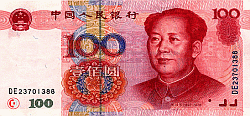 |
|
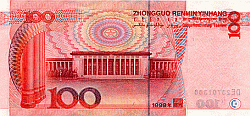 |
| |
|
|
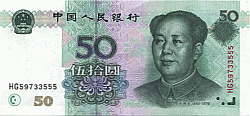 |
|
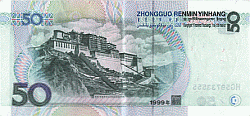 |
| |
|
|
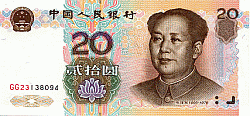 |
|
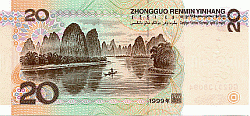 |
| |
|
|
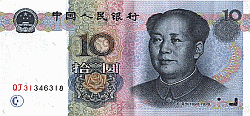 |
|
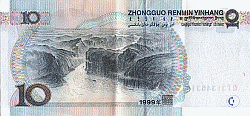 |
| |
|
|
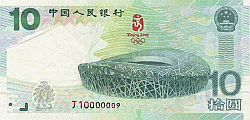 |
|
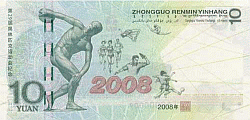 |
| |
|
|
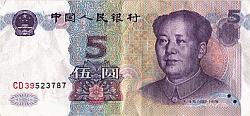 |
|
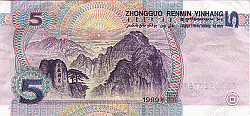 |
| |
|
|
2 RMB Note
only available in the
Old or Ethnic design |
| |
|
|
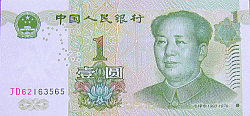 |
|
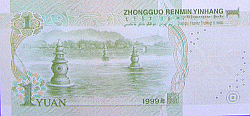 |
| |
|
|
Banknotes smaller
than 1 Renminbe
are only available in the
Old or Ethnic design |
| |
|
|
| Ethnic or Old Style |
|
|
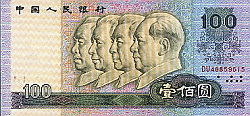 |
|
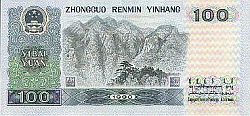 |
| |
|
|
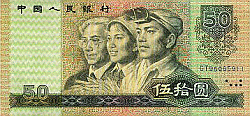 |
|
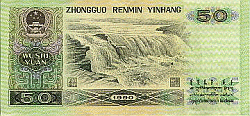 |
| |
|
|
20 RMB Note
only available in the
New or Beijing design |
| |
|
|
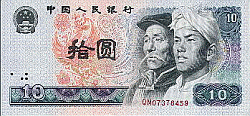 |
|
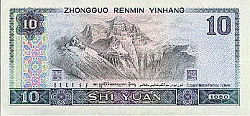 |
| |
|
|
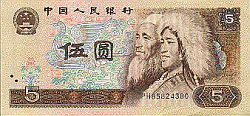 |
|
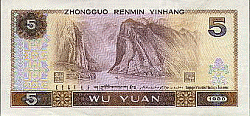 |
| |
|
|
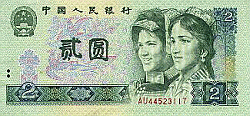 |
|
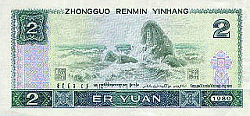 |
| |
|
|
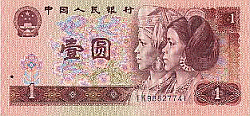 |
|
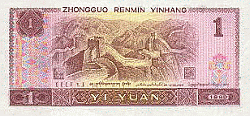 |
| |
|
|
Below are the three banknotes worth
less than 1 Renminbe
They are physically smaller in size and only available
in the Old or Ethnic design |
 |
|
 |
| |
|
|
 |
|
 |
| |
|
|
 |
|
 |
| |
|
|
| China also uses coins, although
these are not commonly used in most areas of China. |
| |
|
|
Jiao coins (10th RMB):
1 RMB, 5 Jiao, 1 Jiao
- these feel heavier |
|
Fen coins (100th RMB):
5 Fen, 2 Fen, 1 Fen
- these are very light (Aluminium) |
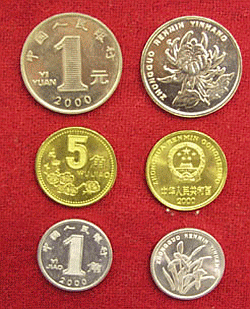 |
|
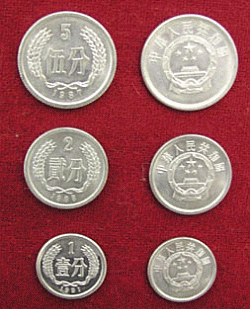 |
| |
|
|
|
Further Reading
For those seeking a brief explanation for the banknotes
and what the pictures represent, please read on:
Currency:
Renminbe: Chinese Currency is called Renminbe (RMB or
CNY) means "People's Currency" in Chinese
language. It is also commonly called Yuan (From the
Cantonese: Yuanmunbi) and is written as ¥ followed
by numbers to indicate currency (International). When
used to indicate prices on the street it is written
元
Units: Yuan, Jiao (some times called "Mao "
) and Fen. 1 Yuan = 10 Jiao (Mao); 1 Jiao = 10 Fen.
The Renminbe (literally "people's currency")
is the legal tender in the mainland of the People's
Republic of China. It is issued by the People's Bank
of China (PBOC, central bank). The official abbreviation
is CNY, although also commonly abbreviated as "RMB"
or "Yuan".
Chinese paper money usually comes in 1 fen (rare), 2
fen (rare),5 fen (very rare), 1 jiao, 2 jiao, 5 jiao,
1 yuan, 2 yuan, 5 yuan,10 yuan, 20 yuan, 50 yuan and
100 yuan.
One yuan is divided into 10 jiao. One jiao is divided
into 10 fen, pennies in English. The largest denomination
of the Renminbe is the 100 yuan note. The smallest is
the 1 fen coin or note. RMB is issued both in notes
and coins. The paper denominations include100, 50, 20,
10, 5, 2 and 1 yuan; 5, 2 and 1 jiao; and 5, 2 and 1
fen. The denominations of coins are 1 yuan; 5, 2 and
1 jiao; and 5,2 and 1 fen.
In spoken Chinese, "yuan" is often called
as "kwai" and the "jiao" as"mao".
Fen-denomination RMB is rarely used, except at supermarkets.
The following are descriptions of major features of
the above 1-yuan banknotes. It is easy to tell various
denominations of RMB since there are corresponding Arabic
numerals printed on every paper note or coin.
Banknotes:
The 1-yuan banknote has two types, the red one debuted
in 1996 while the green one in 1999. The obverse of
the 1996-type 1-yuan note is a portrait of two women
from two minorities, and the reverse is the Great Wall.
The obverse of the 1999-type 1-yuan note is a portrait
of former Chinese leader Mao Zedong, while the reverse
is the Xihu Lake in the southeastern Chinese city Hangzhou.
The 2-yuan banknote is in green. Its obverse is also
a portrait of two women from another two minorities,
and the reverse is the South China Sea.
The 5-yuan banknote also has two types, the brown one
designed and issued in 1980 while the purple one in
1999. The obverse of the 1980-type is a portrait of
two minority people -- a Tibetan woman and a Muslim
man, while the reverse is a scenic picture of the Yangtze
River, the country's longest one. The obverse of the
1999-type is a portrait of Mao Zedong and the reverse
is Taishan Maintain, a mountain in east China's Shandong
province listed by the UNESCO as a world natural and
cultural heritage.
The 10-yuan banknote also has two types -- the ordinary
one debuted in 1999 while the special note was issued
on July 8 by the central bank to mark the Beijing Olympic
Games. The obverse of the ordinary one is a portrait
of Mao Zedong while its reverse is the drawing of the
scenic Three Gorges. The special banknote issued on
July 8 has a picture of the National Stadium, or the
Bird's Nest, on its obverse, while its reverse features
the famous ancient Greek marble statue of a discus-thrower,
Discobolus, portraits of athletes and the Arabic numeral
"2008".
The 20-yuan banknote, debuted in 1999, has a portrait
of Mao Zedong and its reverse features a drawing of
the scenic Lijiang River in South China.
The 50-yuan banknote has two types -- one in yellow
and pink debuted in 1990 while the other in green was
issued in 1999. The former type has a portrait of an
intellectual, a farmer and a worker on its obverse while
its reverse features the Hukou Waterfall on the Yellow
River. The 1999-type banknote is currently much more
widely circulated. Its obverse is a portrait of Mao
Zedong and its reverse is the landmark Potala Palace
in Lhasa.
The 100-yuan banknote also has two types -- one in gray
blue which debuted in 1990 while the other in red which
was first released in 1999. The 1990-type note has a
portrait of four former Chinese leaders, namely Mao
Zedong, Zhou Enlai, Liu Shaoqi and ZhuDe, on its obverse
while its reverse is the Jinggangshan Mountain in South
China. Very few of the 1990-type 100-yuan paper notes
are currently circulated in China.
The obverse of the 1999-type 100-yuan notes is a portrait
of Mao Zedong while a picture of the Great Hall of the
People is printed on the reverse.
|
|
This information is as supplied by ourselves, and ably
supported by our friends and various internet portals. |
|
| Search
this Website |
|
|

Professional
Visa Services
Company
Formation Packages
.
|
Hollywood
in China

Traveling Workshops:
Film Production, Acting, Makeup, Modeling, Dance/Yoga,
and Voice.
Sacred Rainbow Tour spectacular
China 2010 |

British Foreign Office
Advice for Travellers
Personal Email Updates |
Down
The Road.org
How We Traded Our Ordinary Lives For a Global Bicycle Touring Adventure

See
Us in China |
Excellent
& Free Online Chinese Language Portal

Thousands of free print-friendly Chinese reference sheets,
tests and revision aids.
Easy Learning format &
Listen to Spoken Words |

Chinese Embassy in UK
Information About China
International Relations
Visa & Consular |

UK Embassy in China
Information About UK
International Relations
Visa & Consular |

|
Excel
Education |
Languages Courses
Study Abroad
Employability
Summer Camps
Information for Teachers |
|

Based in Xi'an,
China's Premiere Travel Agency and International Travel
Community -
Committed to providing:
Best travel deals & current information for all
International Travellers |

Based in Shangri-la,
Yunnan
Province
Dedicated to Exploring Remote Areas of China
Committed to Nature Conservation and Preserving Ethnic
Cultures & Traditions
|
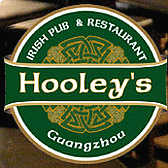 |

Empowering Underprivileged Children
& Their Communities = Worldwide
|

Excellent and relaxing base to
explore beautiful of regions in all China! |

Pearl
Dragon
Vast
Online Trading and Information Resource
Link goes to Chinese Tourism and Galleries Section |
|